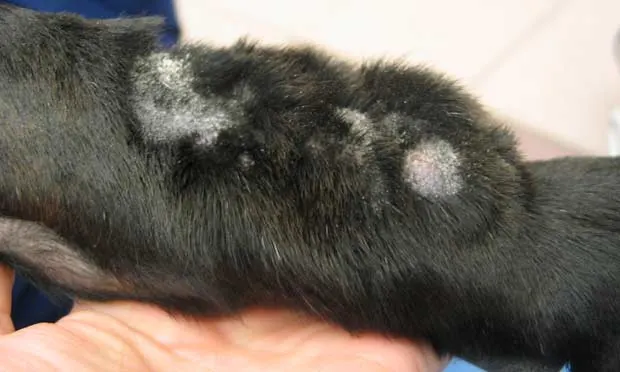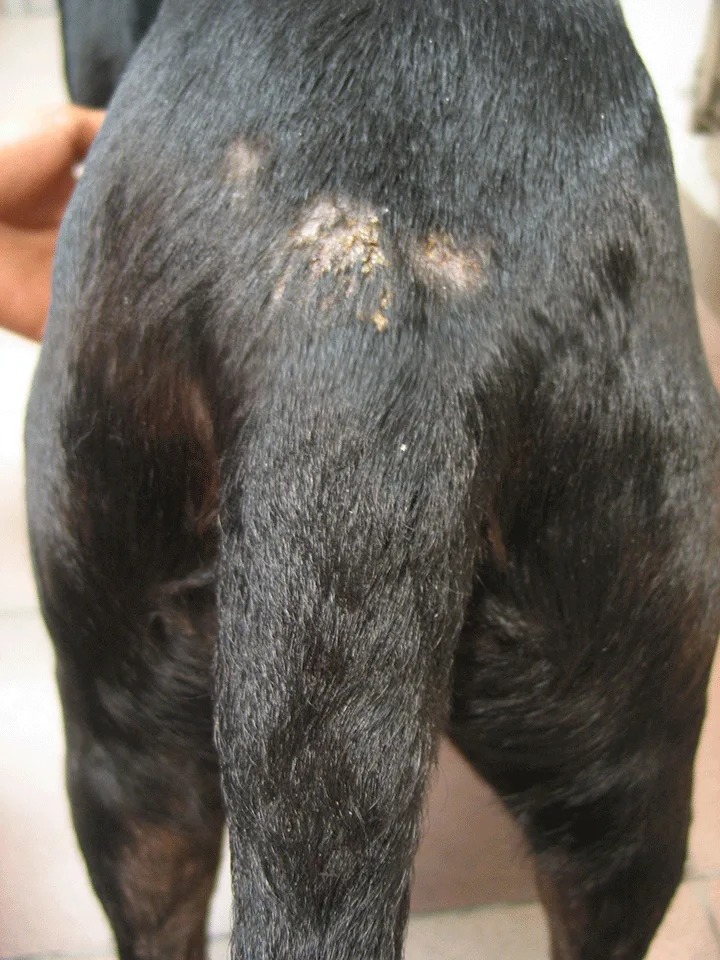Canine Acral Lick Dermatitis
Karin Beale, DVM, DACVD, Gulf Coast Veterinary Specialists

Acral lick dermatitis (lick granuloma) is a lesion induced by chronic licking, most often on a dorsal forelimb between the metacarpals and elbow, although other locations have been noted.
Acral lick dermatitis, which is more common in large-breed dogs, is initiated by pruritus, pain, or behavioral factors, although pruritus may be the most common initiating factor. Careful history and examination are essential to evaluate any potential underlying allergic disease. Signs may include recurrent skin and ear infections, recurrent hot spots, or pruritus associated with other areas (eg, feet, face, trunk). However, pruritus can also result from infection (eg, bacterial, fungal).
The disorder, which is typically diagnosed according to clinical appearance and a patient history of licking the lesion, is characterized by hair loss and an ulcer surrounded by thick plaques. Pain associated with trauma, osteoarthritis, fractures, surgical sites, or peripheral neuropathies may also initiate excessive licking.
Because other conditions may appear clinically similar (eg, deep fungal infection, neoplasia),1 skin biopsy with histopathology is indicated. Diagnostics (eg, digital imaging) may be indicated when there are no signs of pruritus or allergic disease elsewhere.
Although patients may have acral lick dermatitis attributable to a behavioral abnormality, this usually is not the sole cause for the disorder, particularly if the patient has no other behavioral manifestations. However, eventually the licking behavior can become a primary factor.
Secondary problems (ie, bacterial infection, furunculosis [ruptured hair follicles], ruptured apocrine glands) may develop from and can contribute to the patient’s pruritus as well as perpetuate the cycle. These factors should be addressed to resolve the problem.
Related Article: Acral Lick Dermatitis - Behavioral Solutions

Figure 1.
A 6-year-old male Labrador retriever presented with chronic acral lick dermatitis and clinical signs of flea allergy dermatitis (Figures 1, 2, and 3). Tissue collected by biopsy for macerated tissue culture revealed methicillin-sensitive Staphylococcus pseudintermedius (MSSP). The patient was treated with cephalexin at 28 mg/kg q12h and daily dosing of nitenpyram. The patient was also placed in a BiteNot collar.
Determine the primary cause
If the cause of pruritus is not addressed, the lesion will typically recur even after resolution
Allergic Disease
Evaluate signs of allergic disease
Flea allergy dermatitis, adverse food reaction, atopic dermatitis
Depending on signs and history, evaluate need for additional flea control, hypoallergenic diet trial, and allergy medication
Additional Testing
Perform skin scrapings to rule out demodicosis
Pursue diagnostic imaging if patient has no signs of pruritus/allergies elsewhere and history suggests painful underlying cause
Related Article: Compulsive Behaviors in Dogs
Address bacterial infections
Of dogs with acral lick dermatitis, 94% have deep bacterial infections2
Deep Infection
Particularly in chronic cases with fibrosis, infection tends to be “walled off” and an extensive course of antibiotics is necessary
Minimum of 4 weeks of antibiotics is indicated; 6–8 weeks or longer is not unusual
Recheck patient after 4 weeks of antibiotic therapy to determine status of clinical signs
Administer antibiotics until there is hair regrowth, resolution of acral lick dermatitis, and no evidence of exudation or moist dermatitis
Culture & Sensitivity Testing
Purulent material can be obtained by aspiration of acral lick dermatitis sample
Alternatively, biopsy lesion and submit sample for macerated tissue culture
Cultured organisms include Staphylococcus (60%), Pseudomonas (8%), and Enterobacter (8%)
Because these organisms are often multi-drug resistant and 25% are methicillin resistant, empirical selection of antibiotics is not recommended
Administer glucocorticoids concurrently with antibiotics
Glucocorticoids
Relieve inflammation and pruritus associated with foreign body reaction to free keratin (because of furunculosis and contents ofruptured apocrine glands)
Used to treat pruritus associated with underlying allergic disease
Discontinue after initial itch has been controlled
Antibiotics
Continue antibiotic administration after discontinuing glucocorticoids (they may mask signs of remaining infection)
Apply physical restraint
Elizabethan or BiteNot collar with or without bandage covering the lesion
Once lesion has completely resolved, remove physical restraint for short periods (with supervision)
Only remove restraint without supervision after the patient has stopped licking
Use topical therapy
Application
Apply 2–3 times q24h in conjunction with systemic antibacterial and antiinflammatory therapy
Owner observation is useful to ensure that topical applications do not cause increased rubbing or licking of lesion
Options
Mupirocin (antibacterial) can be used alone or followed by application of dimethyl sulfoxide (DMSO) to increase penetration
Useful if Staphylococcus species was cultured
DMSO (antiinflammatory)
Synotic (DMSO and corticosteroid)
Bitter Apple spray (taste may discourage licking; bitterapple.com)
Consider behavior & environment
Antianxiety & Behavior-Modifying Drugs
Use in conjunction with medical treatment if anxiety or behavioral abnormalities are potential or known components
Clomipramine (tricyclic antidepressant) at 1–2 mg/kg PO q12h
Fluoxetine (selective serotonin reuptake inhibitor) at 1 mg/kg PO q24h
Additional Considerations
Address environmental factors (ie, excessive confinement, lack of exercise)
Consider Thundershirts (thundershirt.com) for anxiety relief
Look for extensive fibrosis
Causes
Patients with long-standing acral lick dermatitis may have extensive fibrosis surrounding areas of furunculosis
Chronic foreign body reaction and walled-off infection may make resolution difficult
Treatment
CO2 laser ablation of the lesion may be useful
Keep patient in Elizabethan or BiteNot collar
Change bandage daily until surgical site has healed